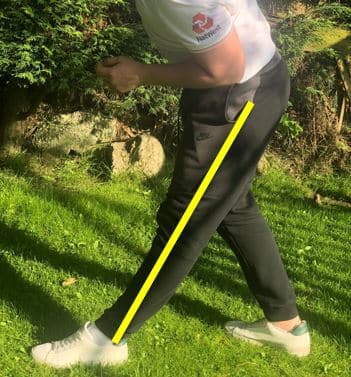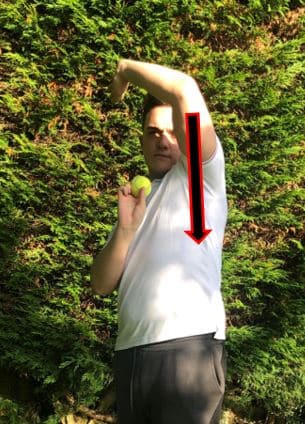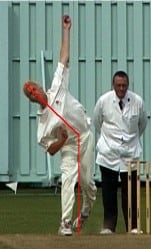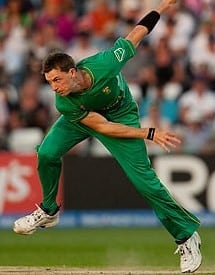A common question from fast bowlers is what can they do to bowl faster? How can they add the extra yard of pace they need to scare the batsman? I think it is every fast bowlers desire to be feared. You want the batsman to be anxious when he sees you marking out your run up and beginning your charge to the crease. All of the great fast bowlers you can think of have possessed this fear factor, be that Mitchell Johnson, Brett Lee, Joel Garner or Harold Larwood!
Thankfully I have good news for you; there are always ways to improve your speed. Some are easier to achieve like making changes to your body and becoming stronger in the right areas physically, whereas others are more difficult such as making subtle changes to your technique and action.
Here are my tips on how to bowl faster in cricket:
- Develop An Effective & Consistent Run Up
- Brace Your Front Leg
- Make Use Of Your Front Arm
- Don’t Bowl Too Much
- Enhance Your Flexibility
- Improve Your Strength
- Align Your Body
- Follow Through & Driving The Hips
I’ll now take you through each of these tips in greater detail, but just a small point to note before we begin – as with a lot of the recommendations I give about making changes to bowling actions, it’s important to remember that the best thing you can do is to find something that works for you and aim to master it! Bowling actions are not ‘one size fits all’, but I believe that getting a few basic things in place can help give you the tools to bowl faster no matter how old you are. Now let’s get to the good stuff…
Develop An Effective & Consistent Run Up
The first thing you should look at when trying to bowl faster is the run up.
The run up is incredibly important because it’s the part of your bowling action that most of the rhythm and momentum is generated from. The momentum that you carry yourself to the crease with will often translate itself to the speed of the ball as it leaves your hand. A couple of examples of incredible fast bowling run ups include those of Brett Lee and the great West Indian fast bowler Michael Holding. Many experts think that Michael Holding in particular possessed the perfect approach to the crease. He even gained his nickname ‘Whispering Death’ because of his famous silent and rhythmical approach. I honestly recommend watching a few videos of Holding/Lee bowling to get a better appreciation of how good at this they really were! If you follow the example set by them, you won’t have many problems as a bowler!
One of the keys for an effective run up is the speed of the approach. It should be fast, although it should never be a full sprint. The goal is to be economical with your movements, as this will ensure that you can bowl for longer periods and don’t tire as easily!
Another important point to note is the length of the run up. Newcomers to cricket will often fall into the trap of thinking that a longer run up = bowling faster. This is not true. Put simply, you just have to find a length that is comfortable for you. You should never feel like you’ve had to run a marathon to get to the crease, but you also should have had the time to build up enough momentum to send the ball down at pace.
Once you have a length that is comfortable, stick with it and practice it. A lot. This will help to ensure that it is easily repeatable and you do not have to think about the length of your strides as you are running in. The length of each stride in a run up should be pretty consistent, however when I started playing I found that the fear of overstepping the line and bowling a no ball caused me to hesitate and have some shorter strides and some longer ones to avoid bowling a no ball. This happens to everyone and it’s also a problem for many professionals! Bowlers who are not confident with their approach get paranoid about overstepping, which eventually affects their performance and speed. Hesitation in the run up kills a lot of the momentum that has been built up on the journey to the crease, leading us to bowl slower and meaning that the run up was largely pointless! The way to avoid this is simply through repetition and practice, which allows us to free our mind of unnecessary things and just concentrate on getting the batsman out!
The run up can be very hard to get right, and that’s why I’ve written a post including all the information I’ve gathered over the years on how to develop the perfect fast bowling run up! If you would like to read that, click here!
Brace Your Front Leg
This tip focuses on the body position at the point of release. The key is to make sure that as you deliver the ball, your front leg is fully straight or ‘braced’ rather than being bent at the knee. A perfect example of this can be seen in the photo below.

This leg position helps a bowler to generate power by forcing the lower part of the body to decelerate very quickly as they slam their front foot down onto the pitch, which causes the upper body to be accelerated forwards.
To help you understand what is happening here, think of a car travelling at 70mph on a motorway. If the driver all of a sudden applies the brakes fully, the car will begin to decelerate rapidly; meanwhile the passengers will feel themselves accelerating forwards. This is a very similar phenomenon to the one that is happening during the bowling action. This means that the front leg is used as the ‘brake’ or the ‘pivot-point’ that the torso will accelerate over the top of. Compare this with a bent front leg at the point of delivery. The deceleration of the lower body is not as sudden, and means that the upper body is not propelled forwards with as much force as it would be with a braced front leg.
This technique is very similar to the ones that javelin throwers use when trying to generate maximum force to propel the javelin from the hand!
To start the process, I would recommend getting a family member or friend to film you bowling so that you can see how your front leg looks at the point that you release the ball. If you see a bend in your front knee, then you are certainly someone who could potentially bowl faster by adding the braced front leg to their bowling action!
Make Use Of Your Front Arm
Something that coaches consistently told me to do when I was younger was to use my front arm more effectively during a delivery if I wanted to bowl faster.
For fast bowlers, the front arm acts as a lever that pulls the rest of the upper body through the bowling action. The photo below shows the sort of position your am should be in during your delivery stride. It is usually somewhere above your head! From here, the speed at which you pull your front arm down will largely determine the speed at which your bowling arm will rotate! The faster the bowling arm rotates, the faster the ball will leave your hand!

A lot of young fast bowlers are prone to pulling their front arm down too early, when in reality, we want this movement to occur as late as possible! If it happens too early, this means that the front arm and bowling arm movements are not closely in sync with one another, and therefore some of the energy generated by the movement of the front arm is lost.
The longer you delay the pulling down of the front arm, the more in sync this will be with the rotation of the bowling arm, meaning that more of the energy generated by the front arm can be used to aid the speed of the rotation. Brett Lee forces this to happen late during his action by extending his front arm high into the air as his back foot lands on the crease. After the high extension occurs, the arm is pulled down quickly and forcefully, which allows the bowling arm to immediately follow and do the same, making him much more likely to bowl faster.
Don’t Bowl Too Much
Ok, so this one is relatively simple, and doesn’t need you to make any changes to your body or your technique! This tip is simply based on the idea that you shouldn’t bowl too much within certain time frames. It takes a lot of effort to bowl fast, and that is often why you’ll see some of the top professional fast bowlers bowling short 5 over spells during test matches. This gives them enough time to restore their energy levels with large rests in between. Fast bowling actions can also put certain areas of your body under high levels of stress, making them vulnerable to injury if overexposed. For example, when a fast bowler slams his front foot down on the crease during the delivery stride, this leads to roughly 10x their body weight travelling through the knee and ankle joints. Overexposing your joints to these types of loads can easily lead to severe problems in those areas.
The ECB came up with a guideline to give bowlers some information on what is considered to be overexposure. They call it the 7/4/2 rule and it reads as follows:
‘In any 7 day period a fast bowler should not bowl more than 4 days in total during that period. They should also only bowl for a maximum of 2 days in a row’
I like to look at it this way: The only way we are able to bowl faster is if we are fit enough and healthy enough to do so. If you have gotten injured as a result of pushing yourself too hard then you will miss practise time and game time, and in that situation there’s no way you can improve your performance! Sometimes, taking a rest day is a good thing because it allows us to remain fresh and ready to compete at our highest level when game time rolls around.
Plus, just because you’re having rest days where you won’t be bowling, that doesn’t mean you can’t work on any of your other cricket skills…Why not check out one of my batting and fielding tips and try to improve in those areas too?
Enhance Your Flexibility
Bowling actions involve many moving parts, and it’s very important that you try to keep these parts healthy if you want to play cricket for a long time.
One of the ways we can achieve this is by stretching. When we stretch what we are really doing is elongating the muscles to prepare them for physical activity. Studies have been performed showing that having an increased level of flexibility allows you to bowl faster, as the range of motion is increased.
So what type of stretches should you be doing? As bowling is centred around multiple different movements, dynamic stretches are the most appropriate to include in your pre-game/pre-practice routine. Dynamic stretches aim to lengthen the muscles by exposing them to a range of motion, as opposed to static stretches which involve holding a certain pose, such as a lunge. As we rarely assume these static positions during the course of a bowling spell, they are not really relevant and therefore should be of low priority during a fast bowlers warm up!
Improve Your Strength
The strength you possess translates heavily to the speed you are capable of bowling. For young bowlers whose bodies are still growing, your strength will increase naturally over the years. This is why a 17 year old with no strength training will be able to bowl faster than a 13 year old with no strength training 9 times out of 10. However, once you are of a certain age and your body is fully grown, you will have to work harder and employ specific training methods to improve in these areas. Here are a few important areas we should look to add strength to and why:
- The core – having a strong, stable core is incredibly helpful to fast bowlers. The core muscles act as a stabiliser during movement, and allow you to transfer force from one area of the body to another, which is very important when trying to bowl fast.
- Legs – Stuart Broad stresses the importance of having strong legs, saying that most of his ability to bowl quickly stems from this area of his body. He claims having a strong lower body is especially important when tasked with bowling on heavily worn pitches, or bowling into a stiff breeze.
- Shoulders – Having healthy shoulders is key to fast bowlers as this is where a large part of the movement takes place during the action. By working all of the muscles that surround the shoulder joint, we have a higher chance of avoiding injury and increasing stability.
Align Your Body
When bowling, it is incredibly important to keep the hips and shoulders in line with each other. This applies to individuals with both front-on and side-on bowling actions!
If a bowler has a ‘mixed action’, like the one shown in the picture below, this has the potential to be very problematic! Having an action like this means that our shoulders and hips are not in line during the delivery. This leads to the top and bottom halves of the body fighting against each other during the most vital part of the action, and also puts huge unwanted pressure on the spine.

Ideally, from the moment that the bowler takes off, as their back and front feet make contact with the crease, and as they make the first step in their follow through, the body should be moving in a straight line. Maintaining your momentum in one direction while transitioning through your delivery stride is an effective way to ensure that the energy we built up during our run up is not lost, and that we bowl faster as a result. It also ensures that we are better protected from injuries.
Good body alignment is something that is usually established at the beginning of your cricket career. As we’ve previously mentioned, it’s critical that as a young player you get into good habits early. If you want to check the alignment of your body when you release the ball, either ask your coaches to examine it or get a friend or family member to stand where the batsman would be and record you bowling. Once you examine the footage, you will know whether it’s necessary to make a change or not!
Follow Through & Driving The Hips
Something a lot of bowlers overlook when trying to bowl faster is the importance of the follow through and making sure that your back leg is pushed through the crease. The follow through is the part of the bowling action that occurs after you release the ball, and it’s more significant than you might think! You might be asking yourself what on earth I mean by ‘pushing your back leg through the crease’, but it’s really quite simple.
Look at the photo of Dale Steyn below. This photo was taken just after the ball has been released. You can see that his left foot is still in the position where it was planted on the crease. However, for this tip we are interested in what Steyn is doing with his right leg. By looking at the photo you can see that he has pulled his right leg through forcefully towards his shoulder, thus extending the bowling action past the crease and continuing his movement down the pitch.

Driving forwards through your hip joint with your back leg after you release the ball helps to ensure that you do not lose momentum by stopping yourself immediately on the crease. Instead this momentum is carried forwards towards the target. This concept of continuing the momentum that we generated during the run up has been a common theme throughout this post and it really is important if you want to bowl faster.
Here’s another little hint which is relatively easy to incorporate into your game. You may hear your coaches speak about the importance of having a straight follow through rather than one that trails away off the pitch. I remember this being mentioned to me many times when I first started playing the game. The theory behind this is that if we continue or momentum straight towards the batsman, rather than trailing off towards the side of the pitch, it gives us a better chance to bowl faster as there is more force directly behind the ball.
Summary
So there are my favourite tips for adding a bit of pace to your deliveries! To wrap this post up, I’d like to stress the fact that it’s incredibly hard to make changes to your technique if you have already been bowling for a number of years. You can’t simply totally remodel your bowling action overnight! The best way to approach the hints I have listed in this article is to take them one at a time and slowly work on them until they feel natural to you, and then you can move on to the next one if required. Also, try to view this post as a checklist! If you can master each of the tips that are included here, then you’ll definitely be able to bowl faster as a result!
